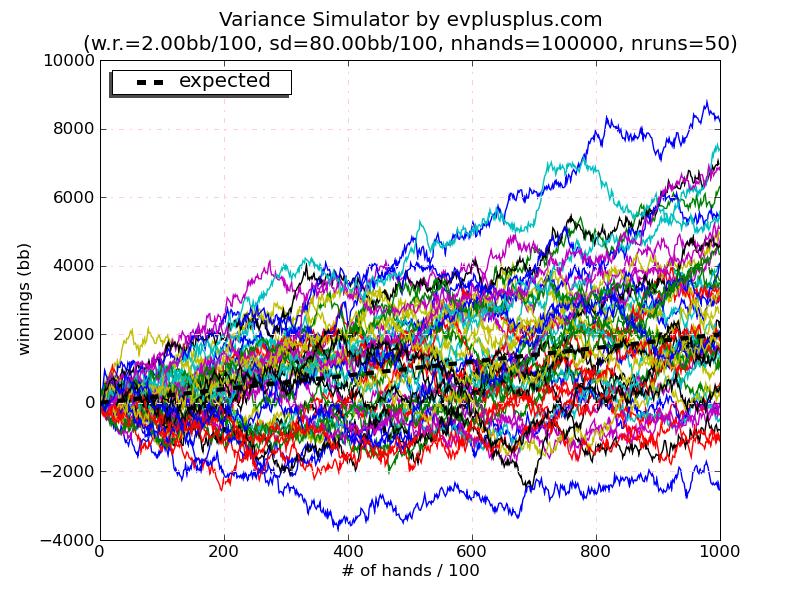Poker Bankroll Management Basics
As we said in the first article, having an adequate bankroll to handle the swings of poker is essential. The ups and downs and break-even stretches are the most difficult things to deal with as a serious poker player and if you can get your head around them, then you’re already at a serious advantage over most of the people you’ll be playing with. People talk about being a winner in ‘the long run’, well the long run is much longer than most people can imagine. It’s not unusual for a small winner to break even for a 100,000 hands and ploughing on through such a stretch is not easy.
Obviously the bigger a winner you are the shorter your breakeven stretches will be. The volume based system in this book benefits from the fact that you’ll reach the long run much quicker when you’re playing a huge volume of hands. If you play 1,000 hands an hour for 4 hours a day, 6 days a week then you’ll reach 100,000 hands in a month. Someone who single tables for an hour or two a few days a week could take a year to get there. On the other hand, when playing so many tables, we’re only maintaining a small edge at each one and so our overall win rate suffers a little bit, meaning that we’ll be subject to longer breakeven stretches in terms of the number of hands than our single tabling friend.
In poker, people generally talk about win rates in terms of big blinds per 100 hands. 6 years ago, win rates of 10 big blinds per 100 hands were possible at stakes as high as $5/$10, but online poker is much harder now and an extremely good player only playing one or two tables would struggle to reach half that win rate at $5/$10. Our system is designed such that you should be making about 2 big blinds per 100 hands at the $0.25/$0.50 tables when you’re fully up and running, and earning the same again in VIP bonuses.
To give you an idea of just how wild the swings can be, I’ve plugged these numbers into a poker variance simulator and ran several trials of 100,000 hands. To do this, you also need the ‘standard deviation’ which, without getting too mathematical, is basically a measure of how wild and aggressive your style is. Our system will see your standard deviation at about 80 big blinds per 100.
As you can see, in the worst case scenario we lose 20 buy-ins over a 100,000 hand sample, even though we’re a winning player, but also in the best case we win 80 buy-ins. This should give you an idea of the swings you can expect to face and show you the importance of putting in a huge volume of hands.
With variance in mind, we need to develop our bankroll strategy for the system. I’m going to assume you’re starting of the $200 and playing the 5c/10c table, buying in for $10 each time. In reality, your winrate should be higher at these low stakes and your breakeven stretches should be shorter. If however, you go on a losing streak you should be prepared to drop down to the lower stakes tables if you reach $150, until you’re back at $200. You should continue playing 5c/10c until you have 25 buy-ins for the next level, which is 10c/20c, so a total account balance of $500. Don’t forget that you can add your VIP bonuses and cash-back to your account balance to make up this $500. If you get off to a bad start at 10c/20c, move back down if your account hits $400 and don’t play there again until you have $500.
Many sites don’t have a level between 10c/20c and 25c/50c, but 888poker have included 15c/30c in their games, so this is your next target. The games will be starting to get a little bit tougher so from now on up, we’ll be imposing a 30 buy-in rule. This means that you shouldn’t move up to 15c/30c until you hit $900 in your account. Again, if you get off to a bad start, make sure to move back down if your balance gets as low as $750. You should continue playing at this level until you reach 30 buy-ins for 25c/50, or $1,500, again moving back down if you drop below $1200 in your account. 25c/50c is the level we’re going to stick at for this system as it represents the sweet spot in terms of difficulty of games vs. your hourly rate. I don’t recommend withdrawing until you can leave yourself with $2,000 to $2,500 in your account and ideally you should always aim to have a 50 buy-in bankroll as a semi-professional player. Once you’ve reached this maintenance level, feel free to withdraw the excess you make each month and spoil yourself!
Final Note: If you don’t exercise good bankroll management, you will go broke no matter how good you are. Don’t ever be tempted to move up to chase losses. Remember, discipline is one of the most important things a poker player can have.


